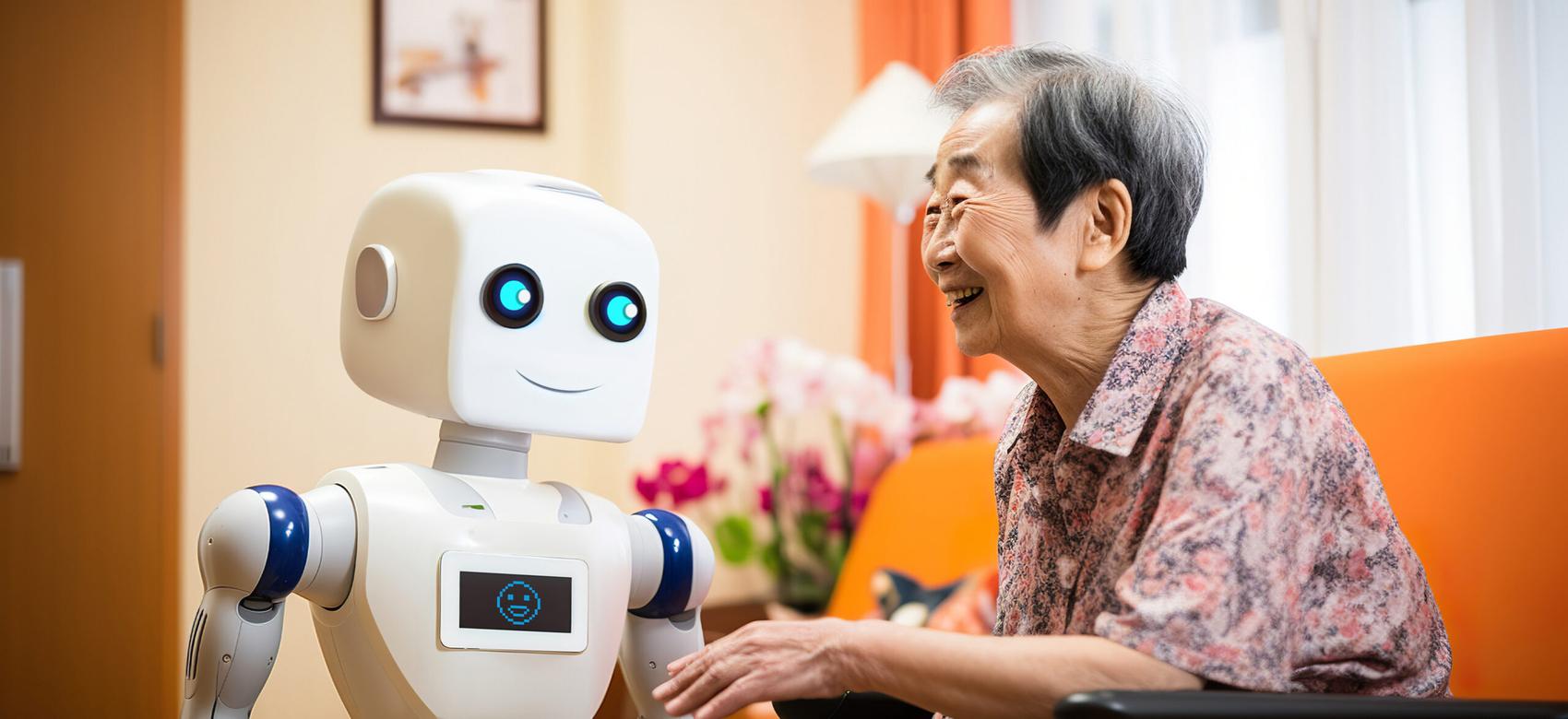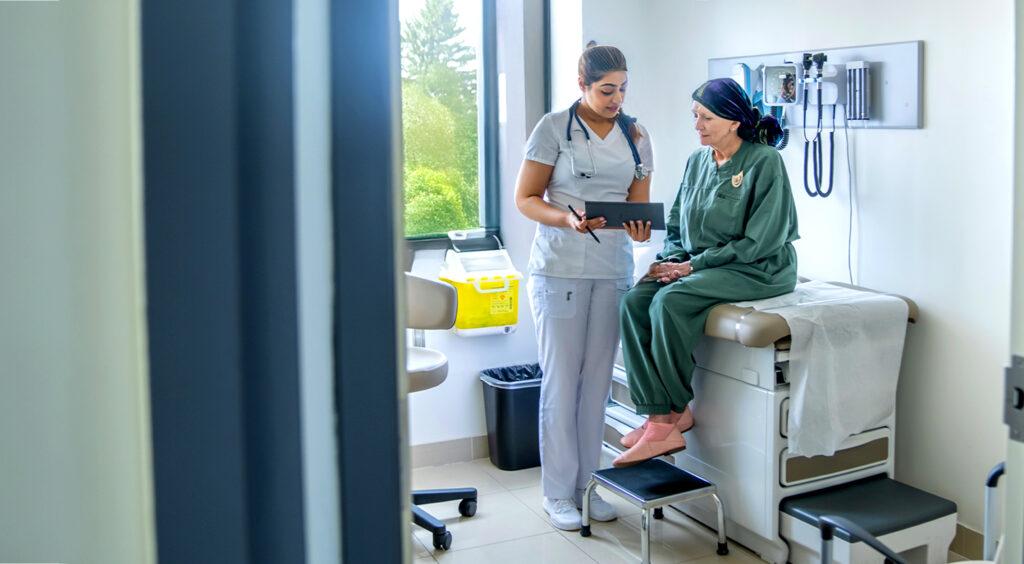How AI social robots could support people living with dementia and their care providers
By Carolyn Ali

Artificial intelligence could help personalize care at home and in long-term care settings
When you think of people who are likely to embrace artificial intelligence, you might not think of older adults and people living with dementia. New technology is usually developed with the needs of young people in mind. But older adults and people living with dementia could benefit greatly from AI—and they may be keener to adopt the technology than you might think.
That’s according to Dr. Lillian Hung, an assistant professor of Nursing at the University of British Columbia, and Canada Research Chair in Senior Care. At UBC’s Innovation in Dementia and Aging (IDEA) Lab, researchers consult with the tech industry to develop more equitable technology, bridging the gap between developers and people living with dementia, their families and care providers.
“People living with dementia can have a good life,” says Dr. Hung. “There are lots of things that can be done to promote healthy aging and brain health in this population. That’s the kind of work that we do.”
Potential of social robots
The concept of “social robots” that provide emotional and social support in eldercare is relatively new in Canada, says Dr. Hung, but it’s more common in countries like Japan. Like a pet that greets you happily at the door, social robots offer companionship and can help alleviate stress and improve moods, without the care requirements of pets.
Dr. Julie Robillard, an associate professor of Neurology at UBC, also studies how emerging technology can support brain health. “Social robots have tremendous potential to support persons living with dementia and their care partners in different areas of daily life,” Dr. Robillard says. Her team at the Neuroscience, Engagement and Smart Tech (NEST) Lab is working with older adults (with and without lived experiences of dementia) and their families and care partners to learn what would help and harm when it comes to social robots.
Here’s how the researchers say personalized technology can help people living with dementia, and what AI could bring in the future.
Emotional and social support in care settings
One example of a social robot is PARO, a robotic pet seal that is used in 80 per cent of nursing homes in Denmark. Dr. Hung’s research with PARO in Canadian care settings shows the potential benefits in long-term care settings here as well.
AI technology is helping to create more interactive social robots. “AI applications will allow us to create robots that are better aligned with the emotions of the person using it,” explains Dr. Robillard. They’re more engaging and responsive, and much more personalized than the “one-size-fits all” devices we have now. “We will see robots that better understand what the user needs in that moment.”
Dr. Hung explains that AI-enabled robots can recognize faces and voices, remember an individual’s likes and dislikes, and build on prior conversations like ChatGPT does. “The robot will use what they know about the person to provide an individualized approach to the conversation, and keep engaging people using machine learning.”
For example, a social robot might have a conversation with an individual and learn that pink is their favourite colour and they like Elvis music. On the next interaction, the robot could flash pink when it says hello and play, “Can’t Help Falling in Love”.
Facilitating connection and easing isolation
Dr. Hung’s team has launched a new study exploring interactions between social robots and older adults. Their goal is to publish and share the results to inform future directions in elder care.
The team is working with people in Vancouver care homes to learn about the needs of users, their families and staff members. She’s observed how the robots have brought individuals with dementia out of their silence and helped ease conversational anxiety for others, allowing them to open up and tell stories.
“We hear very clearly from the community of people living with dementia that there is a lot of stress in everyday life,” Dr. Hung says. “They feel nervous or anxious, and many don’t have access to people to talk to.”
Unlike humans, robots have unlimited time and patience for repetition. “Robots don’t judge,” Dr. Hung says. “They remain polite and the person feels like the robot is really listening to them. That’s what people need, right?”
The robots aren’t meant to replace staff or care providers, but to add emotional and social support, distraction and entertainment. Ironically, she says, the robots have shown to help humanize individuals with dementia in care settings.
“When we bring a robot into a room, people will come together and have a conversation,” she says. “They start to interact with it, and it brings out a humanness in them. The robot doesn’t replace a human. It’s there to facilitate or mediate interactions.”
Balancing risks and benefits
While AI has a lot of potential, Dr. Hung recognizes that fear surrounds it. “People have all kinds of concerns about the robots,” she says. These include data privacy, the conversations the robots could prompt, and care-home staff concerns about potential surveillance.
But that doesn’t mean older adults and their care providers rule them out entirely. “We have to balance the benefits with the risks,” she notes. “It’s about how we mitigate the risks and work together to try to address them.” Her team helps people understand what the robots can and cannot do and helps to establish policies and protocols for using them.
“What is so important right now in the field of AI and older adult care is to hear the voices of those who are impacted by these developments,” says Dr. Robillard. “To know how big a concern AI technology is for the dementia community, we must ask them.”
Her NEST team is looking at questions of which emotions we should share with social robots, how to design robots that are ethical and responsive to older adult values, and how to measure the impact they have.
“With good measures in this area, we’ll be better able to understand in which contexts social robots are most useful and ethical, and establish better evidence around their benefits and harms.”
Personalized reminders and support for daily life
While AI-enabled social robots may be the future of elder care, personalized technology is already making a difference for people living with dementia.
Adapting services to diverse individuals is increasingly important as the Canadian population with dementia continues to diversify. A recent study by the Alzheimer Society notes that by 2050, the number of people of Indigenous ancestry living with dementia in Canada is expected to increase by 273 per cent, from 10,800 to 40,300, and one in four people living with dementia in Canada will be of Asian origin.
Dr. Hung’s team facilitated a study on the user experience of a personalized smart-speaker device that’s now on the market, allowing loved ones to remotely record and send messages, such as daily reminders and comforting recordings. This reminds them of appointments, medication times, basic information like date and day of the week, and conveys emotional reassurance.
“Consistency and keeping it simple is really important for this population,” says Dr. Hung. Personalization of the technology is key: the messages come from a familiar voice and language.
Helping developers create simple devices that are easy for people living with dementia to use helps everyone, Dr. Hung notes. “Accessible technology is the ideal,” she says, and UBC researchers can help bring that ideal into reality.
Carolyn Ali is a writer for UBC Brand and Marketing. With files from Lou Corpuz-Bosshart, UBC Media Relations. This article was published on February 23, 2024. Feel free to republish the text of this article, but please follow our guidelines for attribution and seek any necessary permissions before doing so. Please note that images are not included in this blanket licence.


